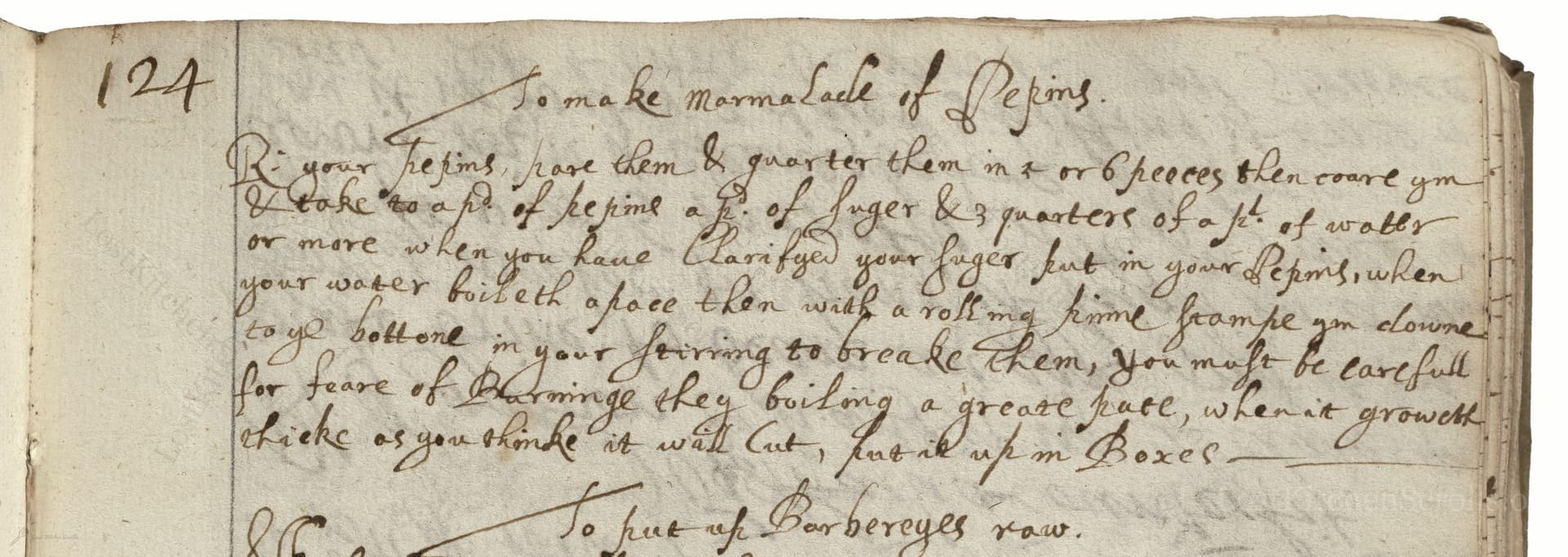To Make Marmalade Of Pepins
From the treasured pages of Cookbook of L. Cromwell
Written by L. Cromwell

To Make Marmalade Of Pepins
"R your Pepins, pare them & quarter them in 5 or 6 peeces then coare ym & take to a pd. of pepins a pd. of Suger & 3 quarters of a pt. of water or more when you have Clarifyed your suger put in your pepins, when your water boileth a pace then with a rolling pinne frampe ym downe to ye bottome in your stirring to breake them, you must be carefull for feare of Burning they boiling a greate pace, when it groweth thicke as you thinke it will cut, put it up in Boxes."
Note on the Original Text
The recipe is written in a typical 17th-century English style: terse, practical, with limited punctuation or standardized spelling. It presumes a degree of kitchen experience—weights are by the pound, and guidance relies on the cook's judgement ('as you thinke it will cut'). Words like 'pare them' (peel), 'quartern them in 5 or 6 peeces' (cut into pieces), 'coare ym' (core them), and 'frampe' (to crush or mash) reflect the evolving language and cooking techniques of the era. The cook is instructed throughout by action and careful observation rather than time or temperature measurements.

Title
Cookbook of L. Cromwell (1650)
You can also click the book image above to peruse the original tome
Writer
L. Cromwell
Era
1650
Publisher
Unknown
Background
Step back into the sumptuous kitchens of the 17th century, where L. Cromwell’s collection stirs up a medley of grand flavors and old English culinary traditions—a true feast for culinary historians and curious cooks alike.
Kindly made available by
Folger Shakespeare Library
This recipe hails from the 17th century, specifically from a manuscript associated with Lady Cromwell in the 1600s. In this period, making preserves such as marmalade was a vital way to store the bounty of the orchard long after harvest, often prepared by ladies of the house or their staff in grand English kitchens. Unlike later citrus marmalades, early English marmalades often used apples, called 'pepins', both for their natural pectin and pleasant tartness. Recipes such as this one are windows into domestic life, resourcefulness, and the tastes of the English gentry at the dawn of modern preserving.

Historic cooks would have used small, sharp knives for paring and coring the apples, likely a large brass or copper preserving pan over an open hearth fire or on a cast-iron range for boiling. Clarifying sugar was often done in a saucepan dedicated for sugar work. The apples were pressed and broken down with a rolling pin or 'framping stick', and the marmalade was decanted into lidded wooden boxes or ceramic pots for storage.
Prep Time
10 mins
Cook Time
40 mins
Servings
6
We've done our best to adapt this historical recipe for modern kitchens, but some details may still need refinement. We warmly welcome feedback from fellow cooks and culinary historians — your insights support the entire community!
Ingredients
- 1 lb apples (preferably tart varieties like Bramley or Granny Smith; any apple can substitute for 'pepins')
- 1 lb white granulated sugar
- 1 1/2 cups water
Instructions
- Begin with tart or dessert apples, about 1 pound (16 ounces).
- Peel the apples and cut them into 5 or 6 pieces each, removing the cores.
- For every 1 pound of apples, measure out 1 pound (16 ounces) of white granulated sugar, and add about 1 1/2 cups of water (or a little more if needed for boiling).
- First, clarify your sugar (this can be done by dissolving it in water and skimming off any scum as it simmers).
- Add your apple pieces to the syrup.
- As the water comes to a vigorous boil, use a rolling pin (or sturdy spoon) to mash the apples down to the bottom while you stir, breaking them up.
- Be careful to stir constantly as the mixture thickens to prevent burning, as it will boil rapidly.
- When the marmalade reaches a thick consistency that looks like it will set when cool, spoon it into jars or boxes to store.
Estimated Calories
180 per serving
Cooking Estimates
It takes about 10 minutes to peel and chop the apples, and about 40 minutes to cook them with the sugar and water until thick. This recipe makes about 6 servings and each serving has around 180 calories.
As noted above, we have made our best effort to translate and adapt this historical recipe for modern kitchens, taking into account ingredients nowadays, cooking techniques, measurements, and so on. However, historical recipes often contain assumptions that require interpretation.
We'd love for anyone to help improve these adaptations. Community contributions are highly welcome. If you have suggestions, corrections, or cooking tips based on your experience with this recipe, please share them below.
Join the Discussion
Rate This Recipe
Dietary Preference
Main Ingredients
Culinary Technique

Den Bockfisch In Einer Fleisch Suppen Zu Kochen
This recipe hails from a German manuscript cookbook compiled in 1696, a time whe...

Die Grieß Nudlen Zumachen
This recipe comes from a rather mysterious manuscript cookbook, penned anonymous...

Ein Boudain
This recipe comes from an anonymous German-language manuscript cookbook from 169...

Ein Gesaltzen Citroni
This recipe, dating from 1696, comes from an extensive anonymous German cookbook...
Browse our complete collection of time-honored recipes



